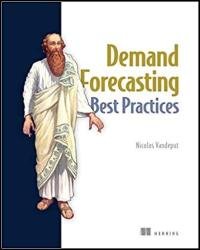 Название: Demand Forecasting Best Practices (Final Release)
Название: Demand Forecasting Best Practices (Final Release)Автор: Nicolas Vandeput
Издательство: Manning Publications
Год: 2023
Страниц: 218
Язык: английский
Формат: pdf (true)
Размер: 10.2 MB
Master the demand forecasting skills you need to decide what resources to acquire, what products to produce, and where and how to distribute them.
Demand Forecasting Best Practices is a handbook of techniques for effective demand planning for products of all types. You'll learn how to optimize your data, metrics, processes, models, and even people to make better decisions and deliver value to your supply chains.
Discover pro tips from author Nicolas Vandeput's global career in supply chain consultancy, and dodge the common mistakes you might not know you're making. Illustrations, clear explanations, and relevant real-world examples make each concept easy to understand and easy to follow.
Throughout the book, I will explain these best practices step by step, highlighting how they will lead you to efficacy (more useful forecasts) and efficiency (reducing your team’s workload while making the most out of their available time). Each chapter will be another opportunity for you to improve your forecasting process and make your forecasts more useful for your supply chain.
Reviewing products’ forecasts requires using advanced, granular, multi-criteria analyses. Unfortunately, the two-dimensional, arbitrary ABC XYZ classifications will never be entirely up to this challenge. How could you fit so many criteria in two dimensions? On the other hand, modern software offers advanced analytics capabilities (Python is your friend) that you can leverage to highlight products requiring your attention. You can, for example, summarize these criteria using a simple star-based rating system. Five-star products should be reviewed first.
• Focus on forecasting demand over the risk-horizon (total supply lead time plus review period) plus a few extra periods to cope with safety stock targets and collaborate with your suppliers.
• Do not focus your team efforts on just a few (or a single) periods as many supply chains do. This is a bad practice.
• Unfortunately, tracking and reporting accuracy over multiple periods will require a robust data management system (because you need to store numerous forecast versions). We will discuss forecasting metrics further in Part 2. Excel won’t do the trick.
• Instead, you will have to use forecasting software or data management tools such as Python.
In Demand Forecasting Best Practices you’ll learn how to:
Lead a demand planning team to improve forecasting quality while reducing workload
Properly define the objectives, granularity, and horizon of your demand planning process
Use smart, value-weighted KPIs to track accuracy and bias
Spot areas of your process where there is room for improvement
Help planners and stakeholders (sales, marketing, finances) add value in your process
Identify what kind of data you should be collecting, and how
Utilize different types of statistical and Machine Learning models
Скачать Demand Forecasting Best Practices (Final Release)